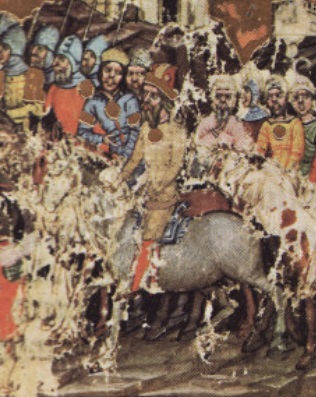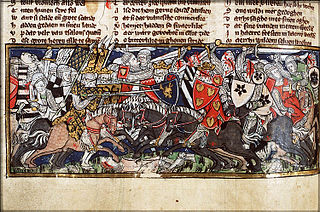Related Research Articles

The Huns were a nomadic people who lived in Central Asia, the Caucasus, and Eastern Europe between the 4th and 6th century AD. According to European tradition, they were first reported living east of the Volga River, in an area that was part of Scythia at the time; the Huns' arrival to Europe is associated with the migration westward of an Iranian people, the Alans. By 370 AD, the Huns had arrived on the Volga, and by 430, they had established a vast, if short-lived, dominion in Europe, conquering the Goths and many other Germanic peoples living outside of Roman borders and causing many others to flee into Roman territory.

Bleda was a Hunnic ruler, the brother of Attila the Hun.

Onegesius was a powerful Hunnic logades (minister) who supposedly held power second only to Attila the Hun. According to Priscus he "seated on a chair to the right of the king" i.e. Attila.
The Hunnic language, or Hunnish, was the language spoken by Huns in the Hunnic Empire, a heterogeneous, multi-ethnic tribal confederation which invaded Eastern and Central Europe, and ruled most of Pannonian Eastern Europe, during the 4th and 5th centuries CE. A variety of languages were spoken within the Hun Empire. A contemporary report by Priscus has that Hunnish was spoken alongside Gothic and the languages of other tribes subjugated by the Huns.

The Sciri, or Scirians, were a Germanic people. They are believed to have spoken an East Germanic language. Their name probably means "the pure ones".
Ernak was the last known ruler of the Huns, and the third son of Attila. After Attila's death in 453 AD, his Empire crumbled and its remains were ruled by his three sons, Ellac, Dengizich and Ernak. He succeeded his older brother Ellac in 454 AD, and probably ruled simultaneously over Huns in dual kingship with his brother Dengizich, but in separate divisions in separate lands.
Rugila or Ruga, was a ruler who was a major factor in the Huns' early victories over the Roman Empire. He served as an important forerunner with his brother Octar, with whom he initially ruled in dual kingship, possibly a geographical division where Rugila ruled over Eastern Huns while Octar over Western Huns, during the 5th century AD.
Dengizich, was a Hunnic ruler and son of Attila. After Attila's death in 453 AD, his Empire crumbled and its remains were ruled by his three sons, Ellac, Dengizich and Ernak. He succeeded his older brother Ellac in 454 AD, and probably ruled simultaneously over the Huns in dual kingship with his brother Ernak, but separate divisions in separate lands.

Uldin, also spelled Huldin is the first ruler of the Huns whose historicity is undisputed.

Ellac was the oldest son of Attila (434–453) and Kreka. After Attila's death in 453 AD, his Empire crumbled and its remains were ruled by his three sons, Ellac, Dengizich and Ernak. He ruled shortly, and died at the Battle of Nedao in 454 AD. Ellac was succeeded by brothers Dengizich and Ernak.
Octar or Ouptaros was a Hunnic ruler. He ruled in dual kingship with his brother Rugila, possibly with a geographical division, ruling the Western Huns while his brother ruled the Eastern Huns.
By the name Edeko are considered three contemporaneous historical figures, whom many scholars identified as one:

Kreka or Hereka was the wife of Attila. She was described by Eastern Roman diplomat Priscus in his account of his stay at Attila's court in 448 or 449 AD. She and Attila had three sons: Ellac, Dengizich, and Ernak, who split among themselves what remained of Attila's empire after his death in 453.

Balamber was ostensibly a chieftain of the Huns, mentioned by Jordanes in his Getica. Jordanes simply called him "king of the Huns" and writes the story of Balamber crushing the tribes of the Ostrogoths in the 370s; somewhere between 370 and more probably 376 AD.
Boz was the king of the Antes, an early Slavic people that lived in parts of present-day Ukraine. His story is mentioned by Jordanes in the Getica (550–551); in the preceding years, the Ostrogoths under Ermanaric had conquered a large number of tribes in Central Europe, including the Antes. Some years after the Ostrogothic defeat by the invading Huns, a king named Vinitharius, Ermanaric's great-nephew, marched against the Antes of Boz and defeated them. Vinitharius condemned Boz, his sons, and seventy of his nobles, to crucifixion, in order to terrorize the Antes. These conflicts constitute the only pre-6th century contacts between Germanics and Slavs documented in written sources.

Laudaricus was a prominent Hunnic chieftain and general active in the first half of the 5th century.
The history of the Huns spans the time from before their first secure recorded appearance in Europe around 370 AD to after the disintegration of their empire around 469. The Huns likely entered Western Asia shortly before 370 from Central Asia: they first conquered the Goths and the Alans, pushing a number of tribes to seek refuge within the Roman Empire. In the following years, the Huns conquered most of the Germanic and Scythian tribes outside of the borders of the Roman Empire. They also launched invasions of both the Asian provinces of Rome and the Sasanian Empire in 375. Under Uldin, the first Hunnic ruler named in contemporary sources, the Huns launched a first unsuccessful large-scale raid into the Eastern Roman Empire in Europe in 408. From the 420s, the Huns were led by the brothers Octar and Ruga, who both cooperated with and threatened the Romans. Upon Ruga's death in 435, his nephews Bleda and Attila became the new rulers of the Huns, and launched a successful raid into the Eastern Roman Empire before making peace and securing an annual tribute and trading raids under the Treaty of Margus. Attila appears to have killed his brother and became sole ruler of the Huns in 445. He would go on to rule for the next eight years, launching a devastating raid on the Eastern Roman Empire in 447, followed by an invasion of Gaul in 451. Attila is traditionally held to have been defeated in Gaul at the Battle of the Catalaunian Fields, however some scholars hold the battle to have been a draw or Hunnic victory. The following year, the Huns invaded Italy and encountered no serious resistance before turning back.
Basich or Basikh was a Hun military commander who co-led an invasion of Persia in 395 AD together with Kursich.
Kursich was a Hun general and royal family member. He led a Hunnish army in the Hunnic invasion of Persia in 395 AD.
Ultzindur was a Hun nobleman and a blood relative of Attila.
References
- 1 2 Maenchen-Helfen 1973, p. 161.
- 1 2 Maenchen-Helfen 1973, p. 162.
- ↑ Maenchen-Helfen 1973, p. 405.
- Sources